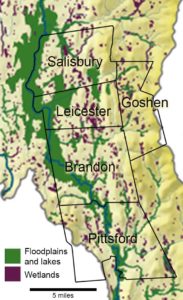Eight towns in Vermont have formed insect control districts to monitor and reduce mosquito populations. Five towns are in the BLSG district, and Cornwall, Weybridge, and Bridport are the Lemon Fair Insect Control District. These contiguous towns are all in Addison or Rutland counties in the Champlain Valley.
Both districts apply a biological larvicide to standing water to kill mosquito larvae. Only the BLSG district also sprays a mist of pesticide along roads to kill adult mosquitos. The extra effort might be justified by the extra mosquitoes which breed in the extensive floodplain swamps and fields along Otter Creek. The central part of the Otter Creek valley is so flat that it is more like a plain than a valley. In the 30 miles between Rutland and Middlebury, Otter Creek drops only 165 feet in elevation. If you follow the wandering course of the creek, you might drop only four feet per mile. The broad, flat swamps and fields along the creek are under water during most springs, and that standing water can allow a lot of mosquitoes to breed.

Brandon, Leicester, and Salisbury formed the first insect control district in 1979. The map above suggests why mosquitoes might have always been such a nuisance there–a lot of flat floodplain is in and near those towns. Goshen has been a member of the district since 1990, and Pittsford fully joined only this year. Goshen is far from the Otter Creek floodplain and well above the swampy valley floor, so it’s not obvious why it joined the district while Ripton and Chittenden (north and south of Goshen) have not.

